Competitive Strategy: Analysis of Key Development Tools and Examples
VerifiedAdded on 2022/08/28
|11
|1916
|25
Essay
AI Summary
This essay provides a comprehensive analysis of competitive strategy, focusing on three key development tools: PESTLE analysis, Porter's Five Forces model, and the Resource-Based View. The essay begins by defining strategy and its importance in achieving organizational goals. It then delves into the PESTLE analysis, examining political, economic, social, technological, legal, and environmental factors using McDonald's as a practical example. Next, the essay applies Porter's Five Forces model to Starbucks, assessing the threat of new entrants, industry rivalry, bargaining power of buyers and suppliers, and the threat of substitutes. Finally, the Resource-Based View is explored using Coca-Cola as a case study, analyzing its valuable, rare, inimitable, and organizational capabilities to achieve a competitive advantage. The essay concludes by summarizing the key findings and emphasizing the importance of these tools in strategic decision-making within the business environment.
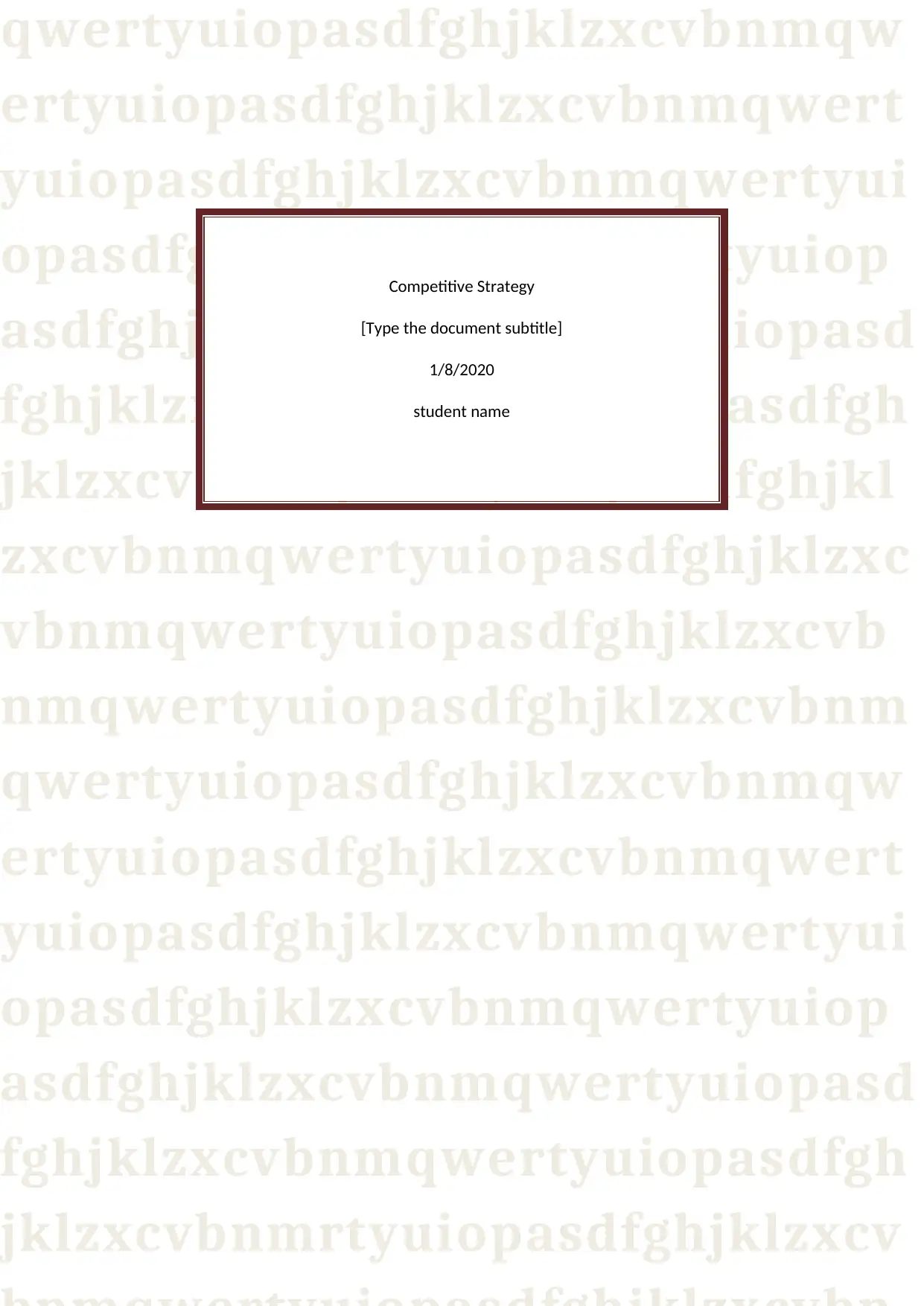
qwertyuiopasdfghjklzxcvbnmqw
ertyuiopasdfghjklzxcvbnmqwert
yuiopasdfghjklzxcvbnmqwertyui
opasdfghjklzxcvbnmqwertyuiop
asdfghjklzxcvbnmqwertyuiopasd
fghjklzxcvbnmqwertyuiopasdfgh
jklzxcvbnmqwertyuiopasdfghjkl
zxcvbnmqwertyuiopasdfghjklzxc
vbnmqwertyuiopasdfghjklzxcvb
nmqwertyuiopasdfghjklzxcvbnm
qwertyuiopasdfghjklzxcvbnmqw
ertyuiopasdfghjklzxcvbnmqwert
yuiopasdfghjklzxcvbnmqwertyui
opasdfghjklzxcvbnmqwertyuiop
asdfghjklzxcvbnmqwertyuiopasd
fghjklzxcvbnmqwertyuiopasdfgh
jklzxcvbnmrtyuiopasdfghjklzxcv
Competitive Strategy
[Type the document subtitle]
1/8/2020
student name
ertyuiopasdfghjklzxcvbnmqwert
yuiopasdfghjklzxcvbnmqwertyui
opasdfghjklzxcvbnmqwertyuiop
asdfghjklzxcvbnmqwertyuiopasd
fghjklzxcvbnmqwertyuiopasdfgh
jklzxcvbnmqwertyuiopasdfghjkl
zxcvbnmqwertyuiopasdfghjklzxc
vbnmqwertyuiopasdfghjklzxcvb
nmqwertyuiopasdfghjklzxcvbnm
qwertyuiopasdfghjklzxcvbnmqw
ertyuiopasdfghjklzxcvbnmqwert
yuiopasdfghjklzxcvbnmqwertyui
opasdfghjklzxcvbnmqwertyuiop
asdfghjklzxcvbnmqwertyuiopasd
fghjklzxcvbnmqwertyuiopasdfgh
jklzxcvbnmrtyuiopasdfghjklzxcv
Competitive Strategy
[Type the document subtitle]
1/8/2020
student name
Paraphrase This Document
Need a fresh take? Get an instant paraphrase of this document with our AI Paraphraser
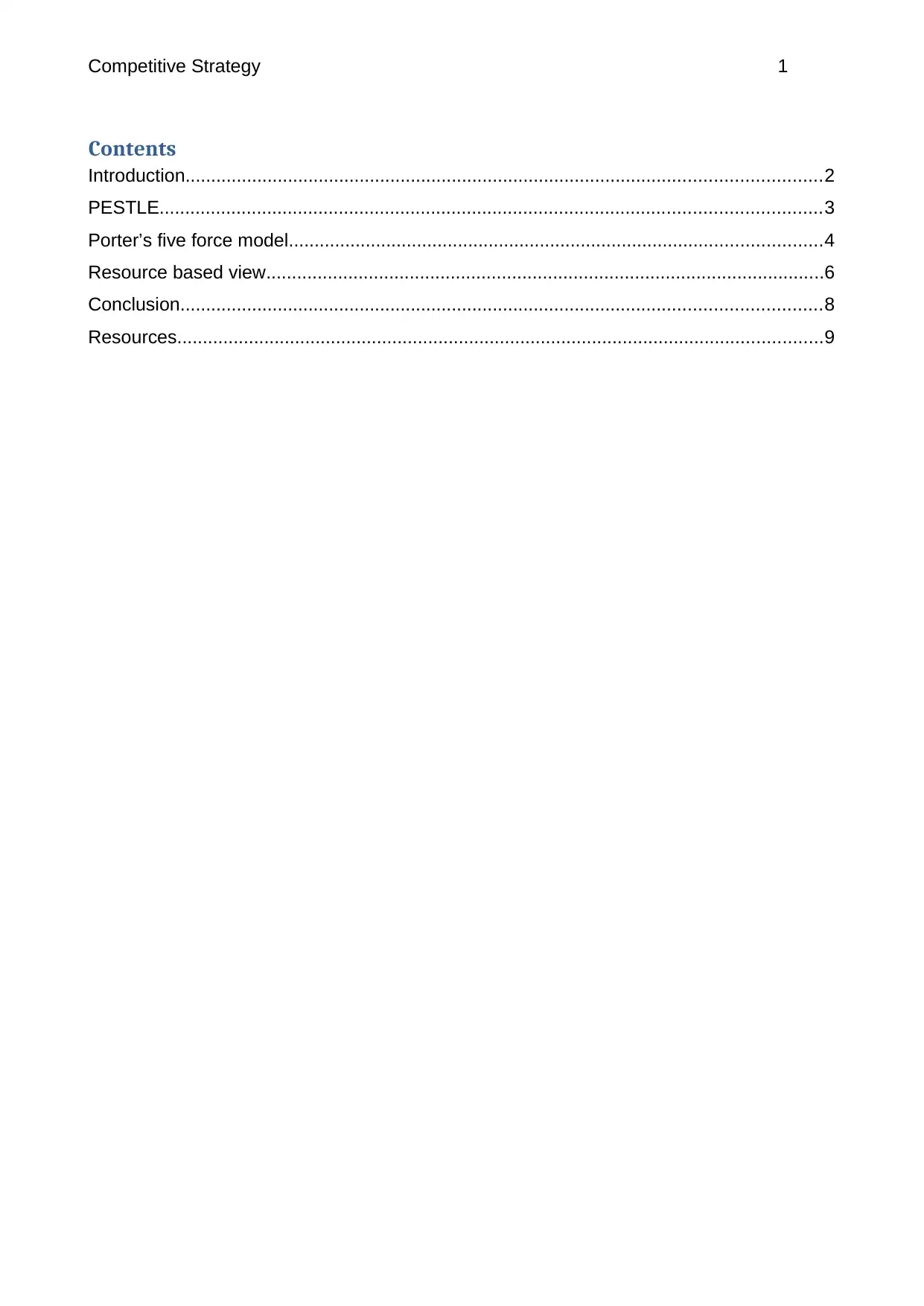
Competitive Strategy 1
Contents
Introduction............................................................................................................................2
PESTLE.................................................................................................................................3
Porter’s five force model........................................................................................................4
Resource based view.............................................................................................................6
Conclusion.............................................................................................................................8
Resources..............................................................................................................................9
Contents
Introduction............................................................................................................................2
PESTLE.................................................................................................................................3
Porter’s five force model........................................................................................................4
Resource based view.............................................................................................................6
Conclusion.............................................................................................................................8
Resources..............................................................................................................................9
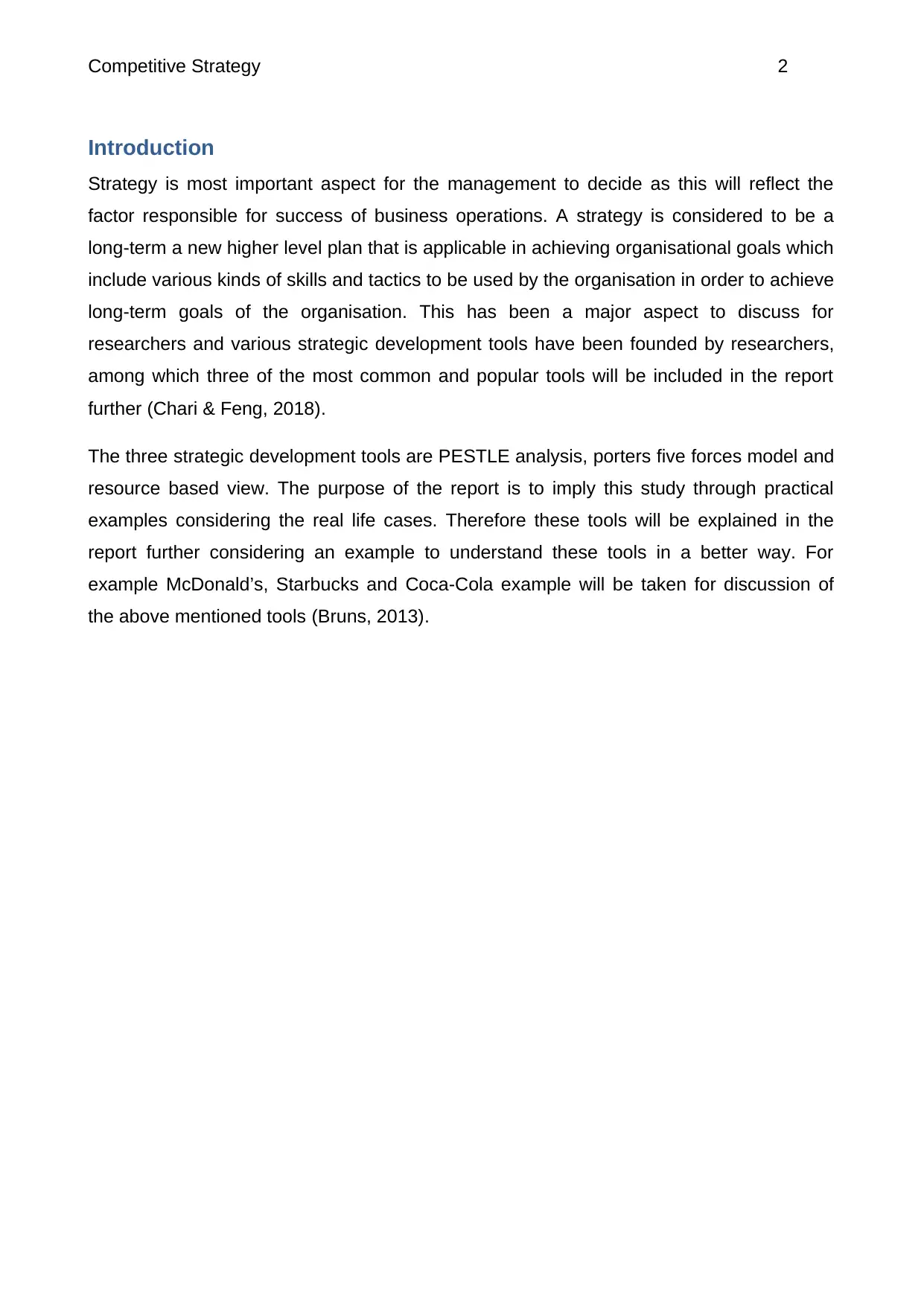
Competitive Strategy 2
Introduction
Strategy is most important aspect for the management to decide as this will reflect the
factor responsible for success of business operations. A strategy is considered to be a
long-term a new higher level plan that is applicable in achieving organisational goals which
include various kinds of skills and tactics to be used by the organisation in order to achieve
long-term goals of the organisation. This has been a major aspect to discuss for
researchers and various strategic development tools have been founded by researchers,
among which three of the most common and popular tools will be included in the report
further (Chari & Feng, 2018).
The three strategic development tools are PESTLE analysis, porters five forces model and
resource based view. The purpose of the report is to imply this study through practical
examples considering the real life cases. Therefore these tools will be explained in the
report further considering an example to understand these tools in a better way. For
example McDonald’s, Starbucks and Coca-Cola example will be taken for discussion of
the above mentioned tools (Bruns, 2013).
Introduction
Strategy is most important aspect for the management to decide as this will reflect the
factor responsible for success of business operations. A strategy is considered to be a
long-term a new higher level plan that is applicable in achieving organisational goals which
include various kinds of skills and tactics to be used by the organisation in order to achieve
long-term goals of the organisation. This has been a major aspect to discuss for
researchers and various strategic development tools have been founded by researchers,
among which three of the most common and popular tools will be included in the report
further (Chari & Feng, 2018).
The three strategic development tools are PESTLE analysis, porters five forces model and
resource based view. The purpose of the report is to imply this study through practical
examples considering the real life cases. Therefore these tools will be explained in the
report further considering an example to understand these tools in a better way. For
example McDonald’s, Starbucks and Coca-Cola example will be taken for discussion of
the above mentioned tools (Bruns, 2013).
⊘ This is a preview!⊘
Do you want full access?
Subscribe today to unlock all pages.

Trusted by 1+ million students worldwide
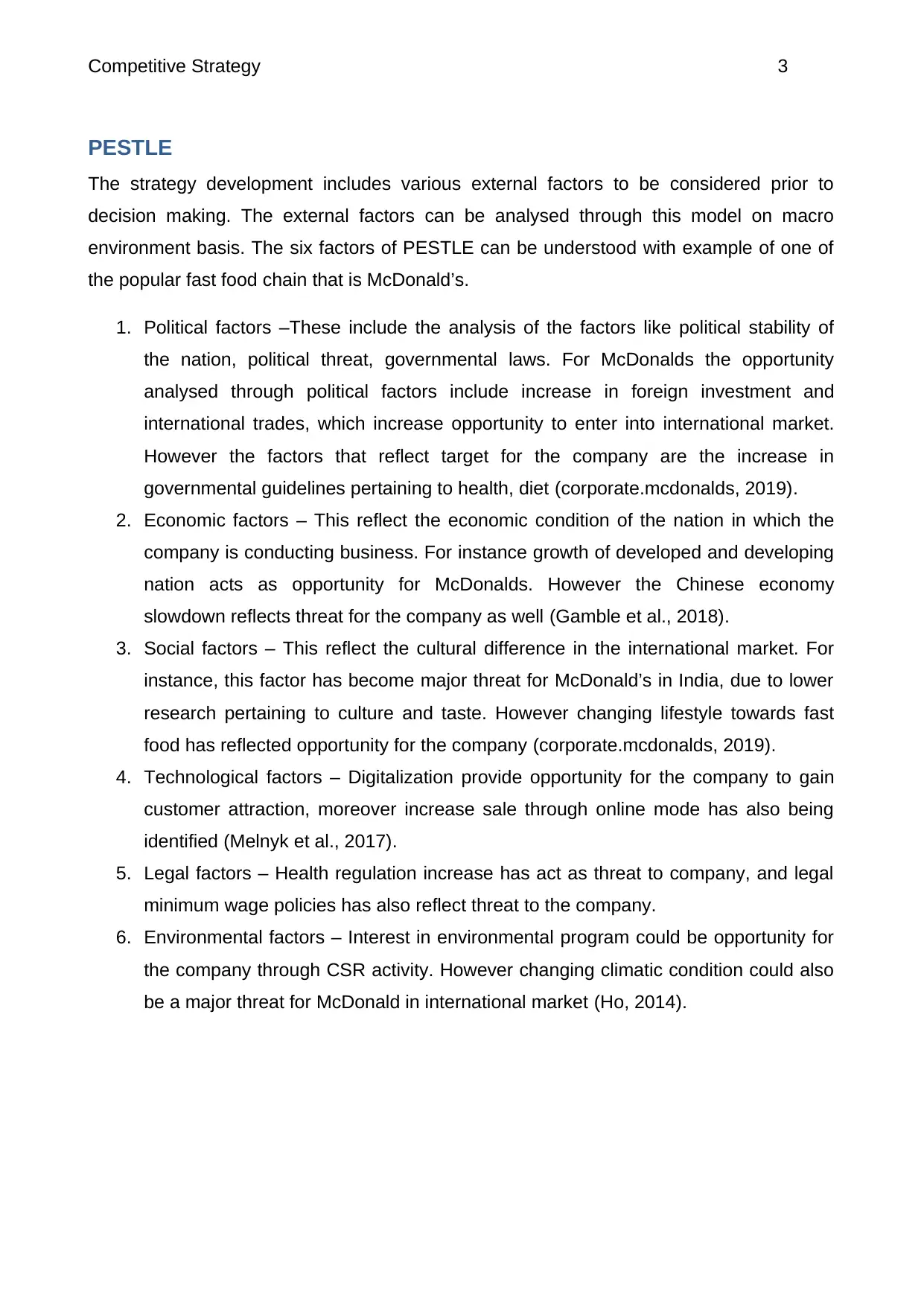
Competitive Strategy 3
PESTLE
The strategy development includes various external factors to be considered prior to
decision making. The external factors can be analysed through this model on macro
environment basis. The six factors of PESTLE can be understood with example of one of
the popular fast food chain that is McDonald’s.
1. Political factors –These include the analysis of the factors like political stability of
the nation, political threat, governmental laws. For McDonalds the opportunity
analysed through political factors include increase in foreign investment and
international trades, which increase opportunity to enter into international market.
However the factors that reflect target for the company are the increase in
governmental guidelines pertaining to health, diet (corporate.mcdonalds, 2019).
2. Economic factors – This reflect the economic condition of the nation in which the
company is conducting business. For instance growth of developed and developing
nation acts as opportunity for McDonalds. However the Chinese economy
slowdown reflects threat for the company as well (Gamble et al., 2018).
3. Social factors – This reflect the cultural difference in the international market. For
instance, this factor has become major threat for McDonald’s in India, due to lower
research pertaining to culture and taste. However changing lifestyle towards fast
food has reflected opportunity for the company (corporate.mcdonalds, 2019).
4. Technological factors – Digitalization provide opportunity for the company to gain
customer attraction, moreover increase sale through online mode has also being
identified (Melnyk et al., 2017).
5. Legal factors – Health regulation increase has act as threat to company, and legal
minimum wage policies has also reflect threat to the company.
6. Environmental factors – Interest in environmental program could be opportunity for
the company through CSR activity. However changing climatic condition could also
be a major threat for McDonald in international market (Ho, 2014).
PESTLE
The strategy development includes various external factors to be considered prior to
decision making. The external factors can be analysed through this model on macro
environment basis. The six factors of PESTLE can be understood with example of one of
the popular fast food chain that is McDonald’s.
1. Political factors –These include the analysis of the factors like political stability of
the nation, political threat, governmental laws. For McDonalds the opportunity
analysed through political factors include increase in foreign investment and
international trades, which increase opportunity to enter into international market.
However the factors that reflect target for the company are the increase in
governmental guidelines pertaining to health, diet (corporate.mcdonalds, 2019).
2. Economic factors – This reflect the economic condition of the nation in which the
company is conducting business. For instance growth of developed and developing
nation acts as opportunity for McDonalds. However the Chinese economy
slowdown reflects threat for the company as well (Gamble et al., 2018).
3. Social factors – This reflect the cultural difference in the international market. For
instance, this factor has become major threat for McDonald’s in India, due to lower
research pertaining to culture and taste. However changing lifestyle towards fast
food has reflected opportunity for the company (corporate.mcdonalds, 2019).
4. Technological factors – Digitalization provide opportunity for the company to gain
customer attraction, moreover increase sale through online mode has also being
identified (Melnyk et al., 2017).
5. Legal factors – Health regulation increase has act as threat to company, and legal
minimum wage policies has also reflect threat to the company.
6. Environmental factors – Interest in environmental program could be opportunity for
the company through CSR activity. However changing climatic condition could also
be a major threat for McDonald in international market (Ho, 2014).
Paraphrase This Document
Need a fresh take? Get an instant paraphrase of this document with our AI Paraphraser
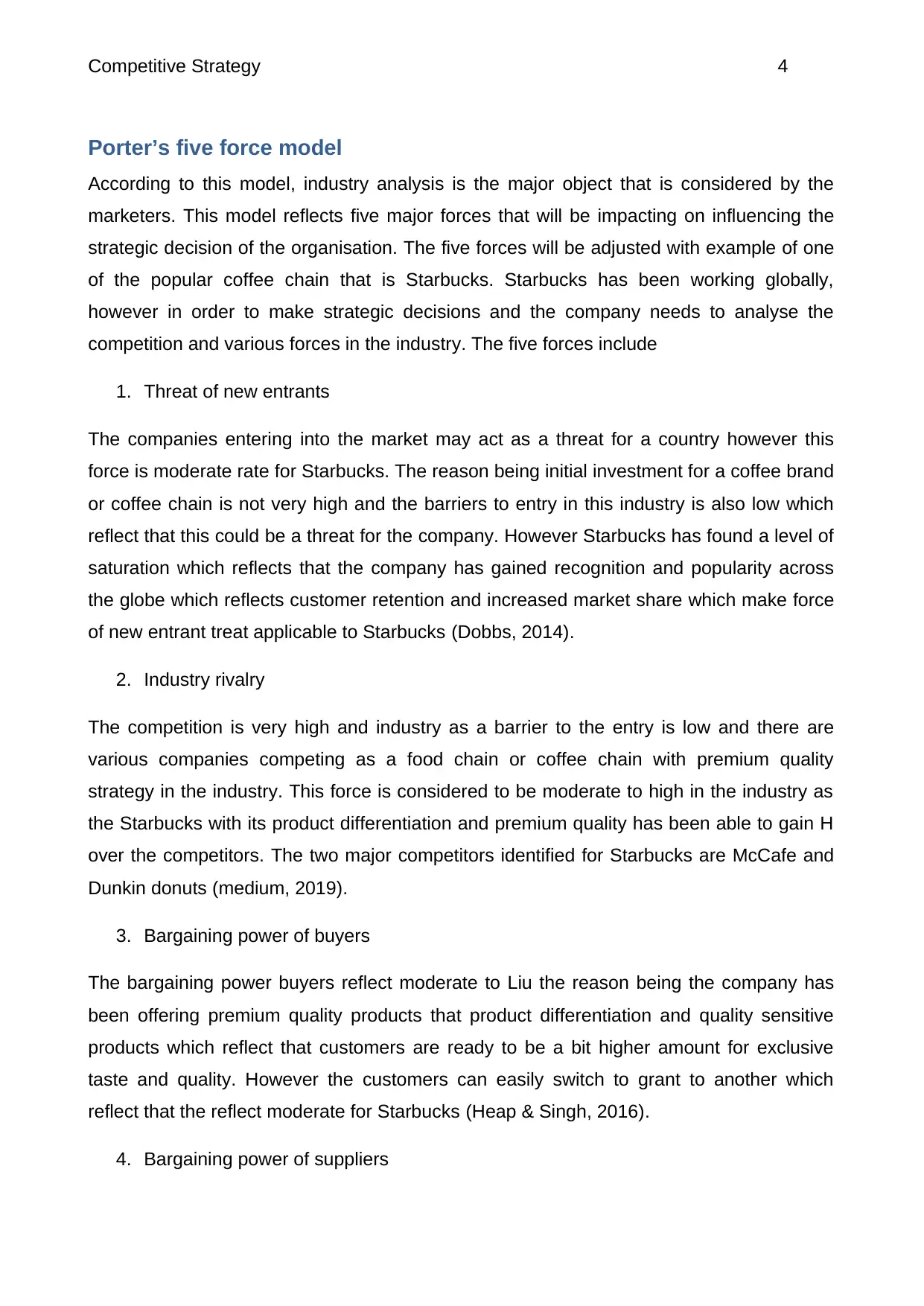
Competitive Strategy 4
Porter’s five force model
According to this model, industry analysis is the major object that is considered by the
marketers. This model reflects five major forces that will be impacting on influencing the
strategic decision of the organisation. The five forces will be adjusted with example of one
of the popular coffee chain that is Starbucks. Starbucks has been working globally,
however in order to make strategic decisions and the company needs to analyse the
competition and various forces in the industry. The five forces include
1. Threat of new entrants
The companies entering into the market may act as a threat for a country however this
force is moderate rate for Starbucks. The reason being initial investment for a coffee brand
or coffee chain is not very high and the barriers to entry in this industry is also low which
reflect that this could be a threat for the company. However Starbucks has found a level of
saturation which reflects that the company has gained recognition and popularity across
the globe which reflects customer retention and increased market share which make force
of new entrant treat applicable to Starbucks (Dobbs, 2014).
2. Industry rivalry
The competition is very high and industry as a barrier to the entry is low and there are
various companies competing as a food chain or coffee chain with premium quality
strategy in the industry. This force is considered to be moderate to high in the industry as
the Starbucks with its product differentiation and premium quality has been able to gain H
over the competitors. The two major competitors identified for Starbucks are McCafe and
Dunkin donuts (medium, 2019).
3. Bargaining power of buyers
The bargaining power buyers reflect moderate to Liu the reason being the company has
been offering premium quality products that product differentiation and quality sensitive
products which reflect that customers are ready to be a bit higher amount for exclusive
taste and quality. However the customers can easily switch to grant to another which
reflect that the reflect moderate for Starbucks (Heap & Singh, 2016).
4. Bargaining power of suppliers
Porter’s five force model
According to this model, industry analysis is the major object that is considered by the
marketers. This model reflects five major forces that will be impacting on influencing the
strategic decision of the organisation. The five forces will be adjusted with example of one
of the popular coffee chain that is Starbucks. Starbucks has been working globally,
however in order to make strategic decisions and the company needs to analyse the
competition and various forces in the industry. The five forces include
1. Threat of new entrants
The companies entering into the market may act as a threat for a country however this
force is moderate rate for Starbucks. The reason being initial investment for a coffee brand
or coffee chain is not very high and the barriers to entry in this industry is also low which
reflect that this could be a threat for the company. However Starbucks has found a level of
saturation which reflects that the company has gained recognition and popularity across
the globe which reflects customer retention and increased market share which make force
of new entrant treat applicable to Starbucks (Dobbs, 2014).
2. Industry rivalry
The competition is very high and industry as a barrier to the entry is low and there are
various companies competing as a food chain or coffee chain with premium quality
strategy in the industry. This force is considered to be moderate to high in the industry as
the Starbucks with its product differentiation and premium quality has been able to gain H
over the competitors. The two major competitors identified for Starbucks are McCafe and
Dunkin donuts (medium, 2019).
3. Bargaining power of buyers
The bargaining power buyers reflect moderate to Liu the reason being the company has
been offering premium quality products that product differentiation and quality sensitive
products which reflect that customers are ready to be a bit higher amount for exclusive
taste and quality. However the customers can easily switch to grant to another which
reflect that the reflect moderate for Starbucks (Heap & Singh, 2016).
4. Bargaining power of suppliers
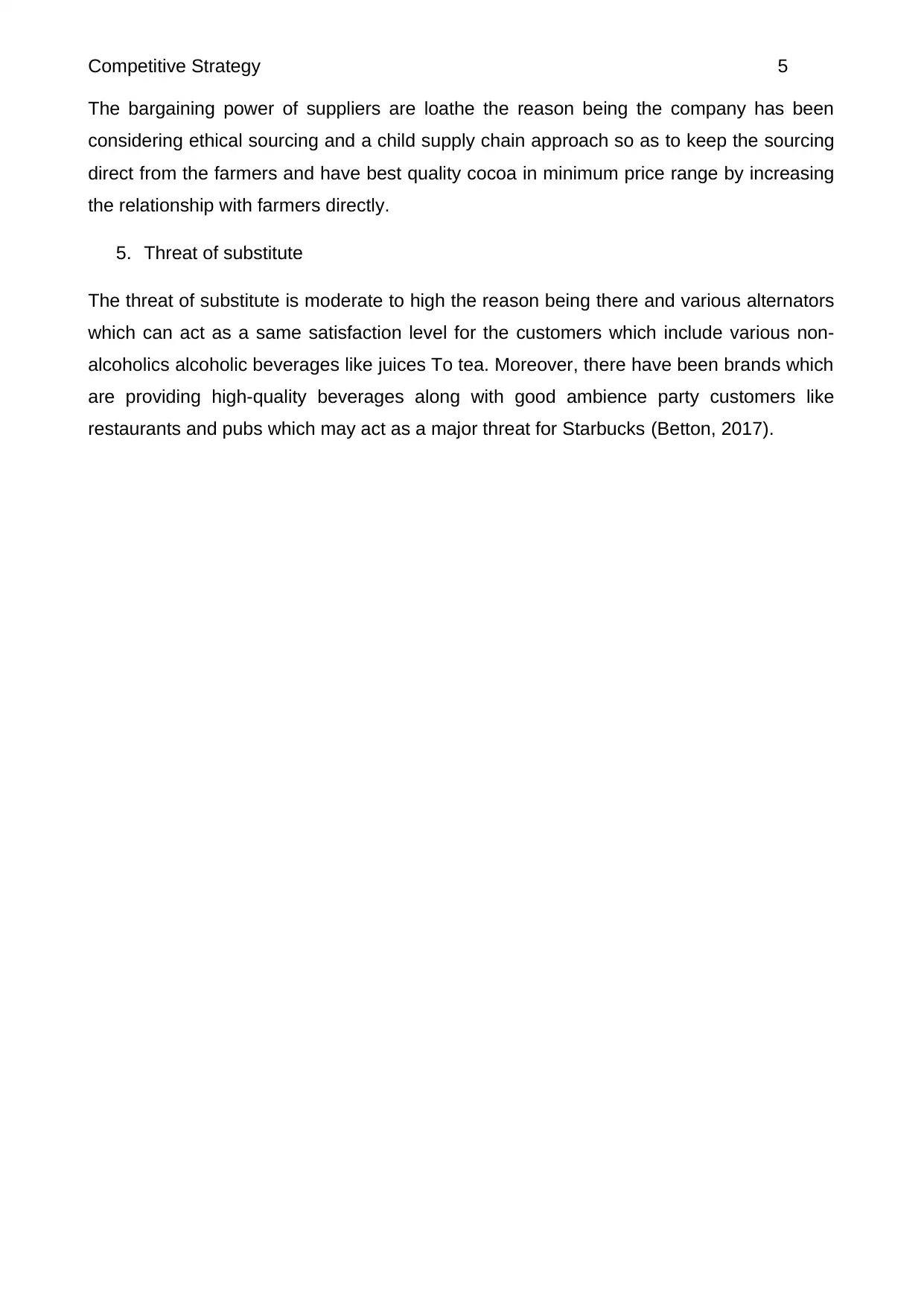
Competitive Strategy 5
The bargaining power of suppliers are loathe the reason being the company has been
considering ethical sourcing and a child supply chain approach so as to keep the sourcing
direct from the farmers and have best quality cocoa in minimum price range by increasing
the relationship with farmers directly.
5. Threat of substitute
The threat of substitute is moderate to high the reason being there and various alternators
which can act as a same satisfaction level for the customers which include various non-
alcoholics alcoholic beverages like juices To tea. Moreover, there have been brands which
are providing high-quality beverages along with good ambience party customers like
restaurants and pubs which may act as a major threat for Starbucks (Betton, 2017).
The bargaining power of suppliers are loathe the reason being the company has been
considering ethical sourcing and a child supply chain approach so as to keep the sourcing
direct from the farmers and have best quality cocoa in minimum price range by increasing
the relationship with farmers directly.
5. Threat of substitute
The threat of substitute is moderate to high the reason being there and various alternators
which can act as a same satisfaction level for the customers which include various non-
alcoholics alcoholic beverages like juices To tea. Moreover, there have been brands which
are providing high-quality beverages along with good ambience party customers like
restaurants and pubs which may act as a major threat for Starbucks (Betton, 2017).
⊘ This is a preview!⊘
Do you want full access?
Subscribe today to unlock all pages.

Trusted by 1+ million students worldwide
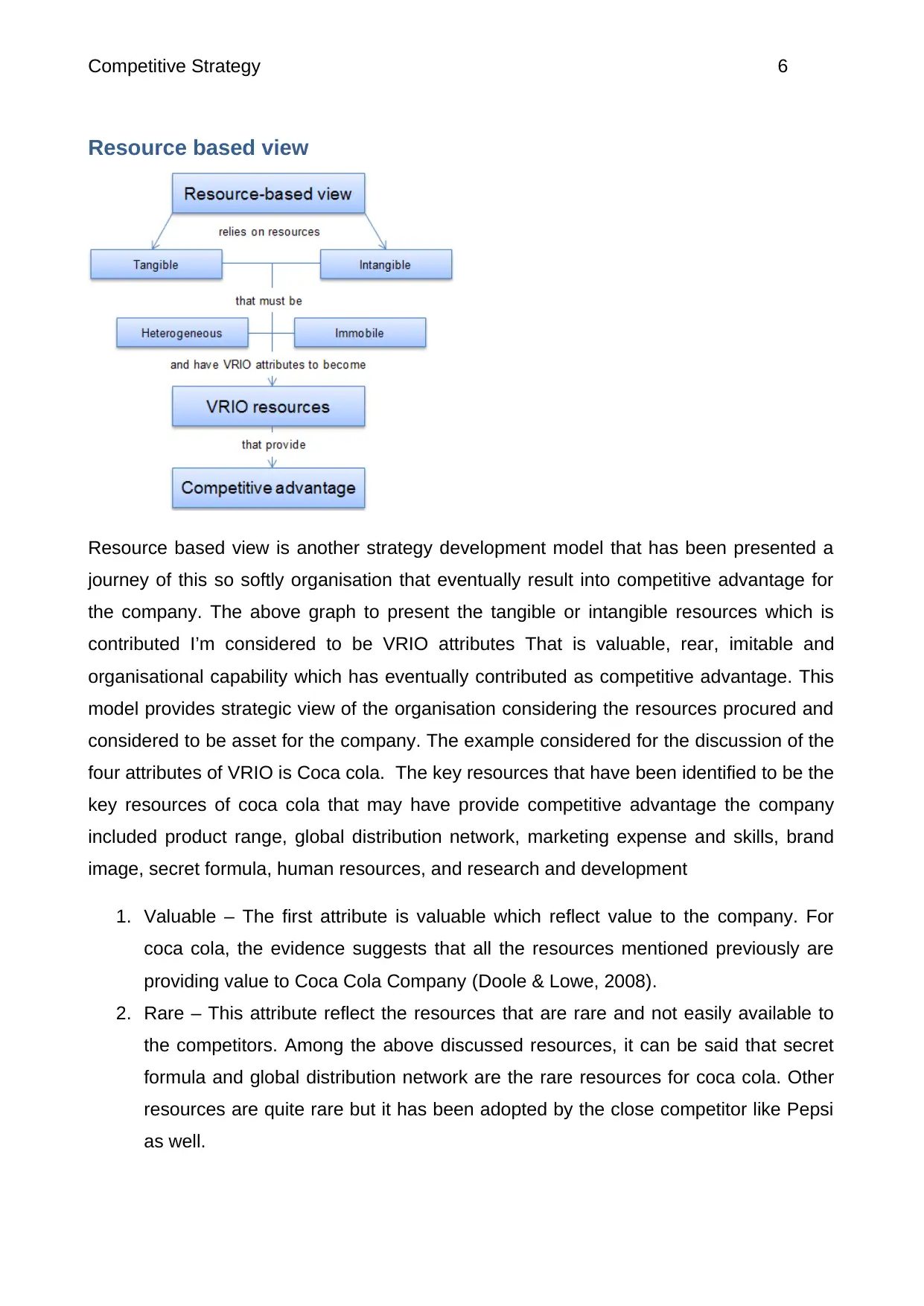
Competitive Strategy 6
Resource based view
Resource based view is another strategy development model that has been presented a
journey of this so softly organisation that eventually result into competitive advantage for
the company. The above graph to present the tangible or intangible resources which is
contributed I’m considered to be VRIO attributes That is valuable, rear, imitable and
organisational capability which has eventually contributed as competitive advantage. This
model provides strategic view of the organisation considering the resources procured and
considered to be asset for the company. The example considered for the discussion of the
four attributes of VRIO is Coca cola. The key resources that have been identified to be the
key resources of coca cola that may have provide competitive advantage the company
included product range, global distribution network, marketing expense and skills, brand
image, secret formula, human resources, and research and development
1. Valuable – The first attribute is valuable which reflect value to the company. For
coca cola, the evidence suggests that all the resources mentioned previously are
providing value to Coca Cola Company (Doole & Lowe, 2008).
2. Rare – This attribute reflect the resources that are rare and not easily available to
the competitors. Among the above discussed resources, it can be said that secret
formula and global distribution network are the rare resources for coca cola. Other
resources are quite rare but it has been adopted by the close competitor like Pepsi
as well.
Resource based view
Resource based view is another strategy development model that has been presented a
journey of this so softly organisation that eventually result into competitive advantage for
the company. The above graph to present the tangible or intangible resources which is
contributed I’m considered to be VRIO attributes That is valuable, rear, imitable and
organisational capability which has eventually contributed as competitive advantage. This
model provides strategic view of the organisation considering the resources procured and
considered to be asset for the company. The example considered for the discussion of the
four attributes of VRIO is Coca cola. The key resources that have been identified to be the
key resources of coca cola that may have provide competitive advantage the company
included product range, global distribution network, marketing expense and skills, brand
image, secret formula, human resources, and research and development
1. Valuable – The first attribute is valuable which reflect value to the company. For
coca cola, the evidence suggests that all the resources mentioned previously are
providing value to Coca Cola Company (Doole & Lowe, 2008).
2. Rare – This attribute reflect the resources that are rare and not easily available to
the competitors. Among the above discussed resources, it can be said that secret
formula and global distribution network are the rare resources for coca cola. Other
resources are quite rare but it has been adopted by the close competitor like Pepsi
as well.
Paraphrase This Document
Need a fresh take? Get an instant paraphrase of this document with our AI Paraphraser
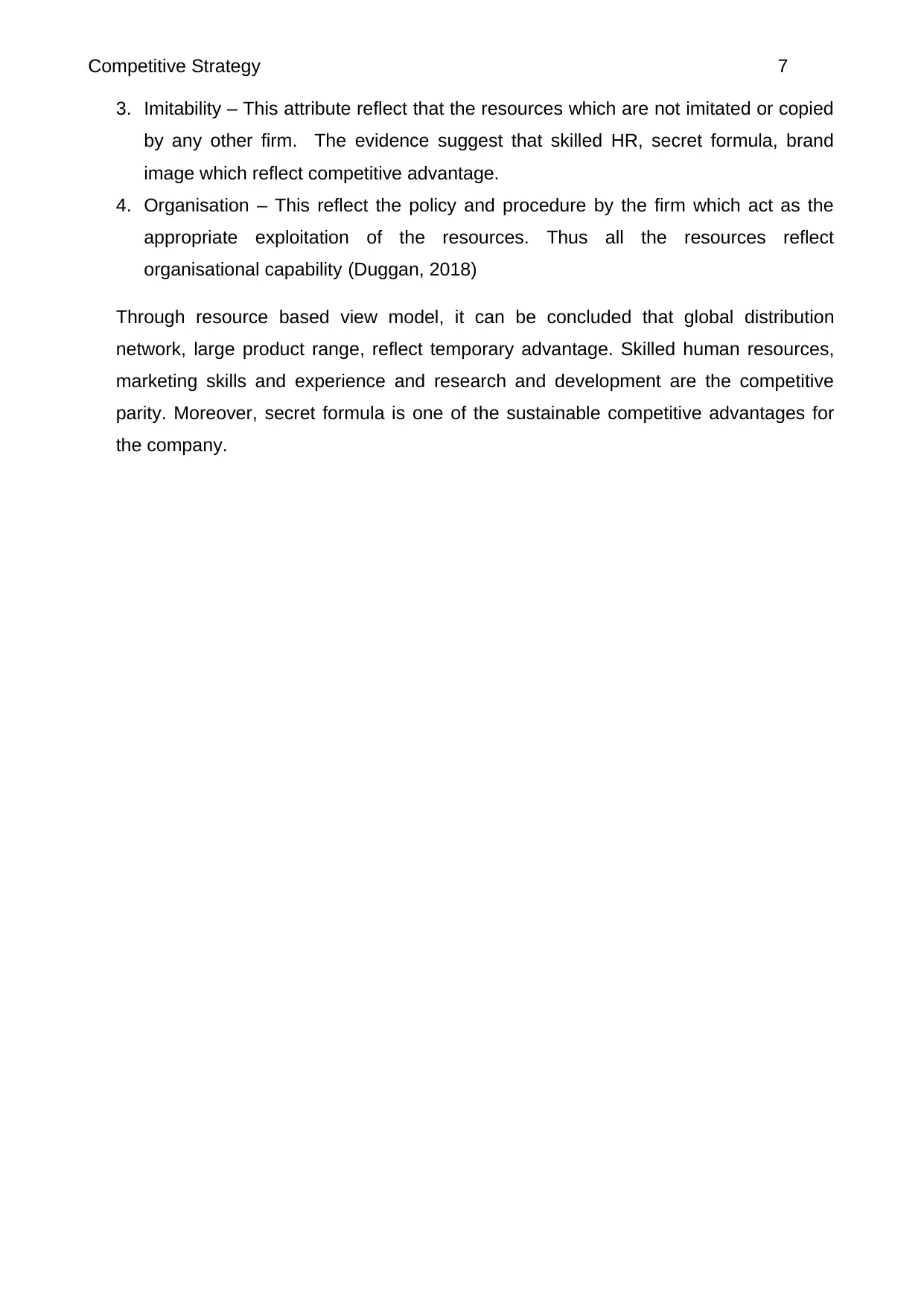
Competitive Strategy 7
3. Imitability – This attribute reflect that the resources which are not imitated or copied
by any other firm. The evidence suggest that skilled HR, secret formula, brand
image which reflect competitive advantage.
4. Organisation – This reflect the policy and procedure by the firm which act as the
appropriate exploitation of the resources. Thus all the resources reflect
organisational capability (Duggan, 2018)
Through resource based view model, it can be concluded that global distribution
network, large product range, reflect temporary advantage. Skilled human resources,
marketing skills and experience and research and development are the competitive
parity. Moreover, secret formula is one of the sustainable competitive advantages for
the company.
3. Imitability – This attribute reflect that the resources which are not imitated or copied
by any other firm. The evidence suggest that skilled HR, secret formula, brand
image which reflect competitive advantage.
4. Organisation – This reflect the policy and procedure by the firm which act as the
appropriate exploitation of the resources. Thus all the resources reflect
organisational capability (Duggan, 2018)
Through resource based view model, it can be concluded that global distribution
network, large product range, reflect temporary advantage. Skilled human resources,
marketing skills and experience and research and development are the competitive
parity. Moreover, secret formula is one of the sustainable competitive advantages for
the company.
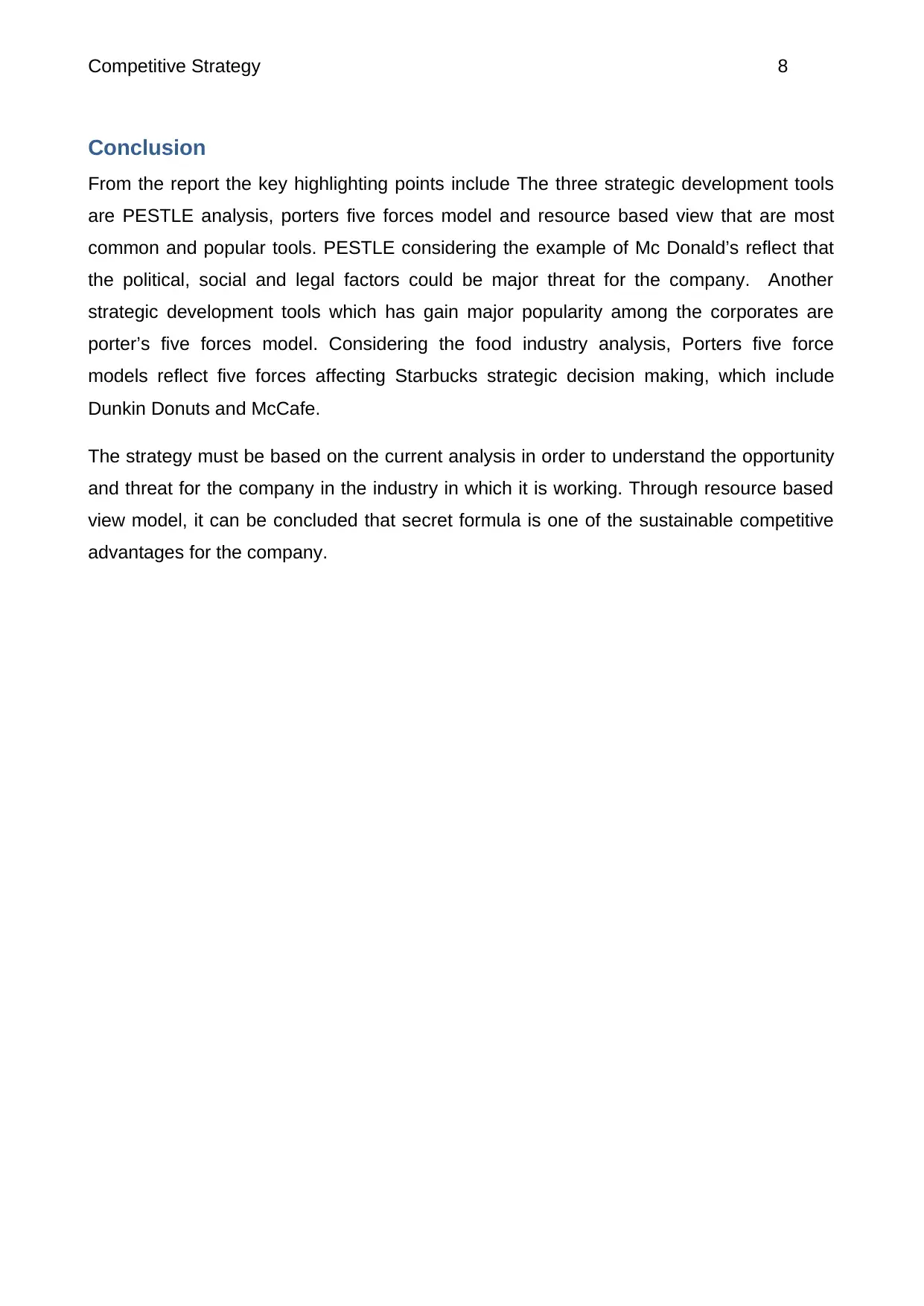
Competitive Strategy 8
Conclusion
From the report the key highlighting points include The three strategic development tools
are PESTLE analysis, porters five forces model and resource based view that are most
common and popular tools. PESTLE considering the example of Mc Donald’s reflect that
the political, social and legal factors could be major threat for the company. Another
strategic development tools which has gain major popularity among the corporates are
porter’s five forces model. Considering the food industry analysis, Porters five force
models reflect five forces affecting Starbucks strategic decision making, which include
Dunkin Donuts and McCafe.
The strategy must be based on the current analysis in order to understand the opportunity
and threat for the company in the industry in which it is working. Through resource based
view model, it can be concluded that secret formula is one of the sustainable competitive
advantages for the company.
Conclusion
From the report the key highlighting points include The three strategic development tools
are PESTLE analysis, porters five forces model and resource based view that are most
common and popular tools. PESTLE considering the example of Mc Donald’s reflect that
the political, social and legal factors could be major threat for the company. Another
strategic development tools which has gain major popularity among the corporates are
porter’s five forces model. Considering the food industry analysis, Porters five force
models reflect five forces affecting Starbucks strategic decision making, which include
Dunkin Donuts and McCafe.
The strategy must be based on the current analysis in order to understand the opportunity
and threat for the company in the industry in which it is working. Through resource based
view model, it can be concluded that secret formula is one of the sustainable competitive
advantages for the company.
⊘ This is a preview!⊘
Do you want full access?
Subscribe today to unlock all pages.

Trusted by 1+ million students worldwide
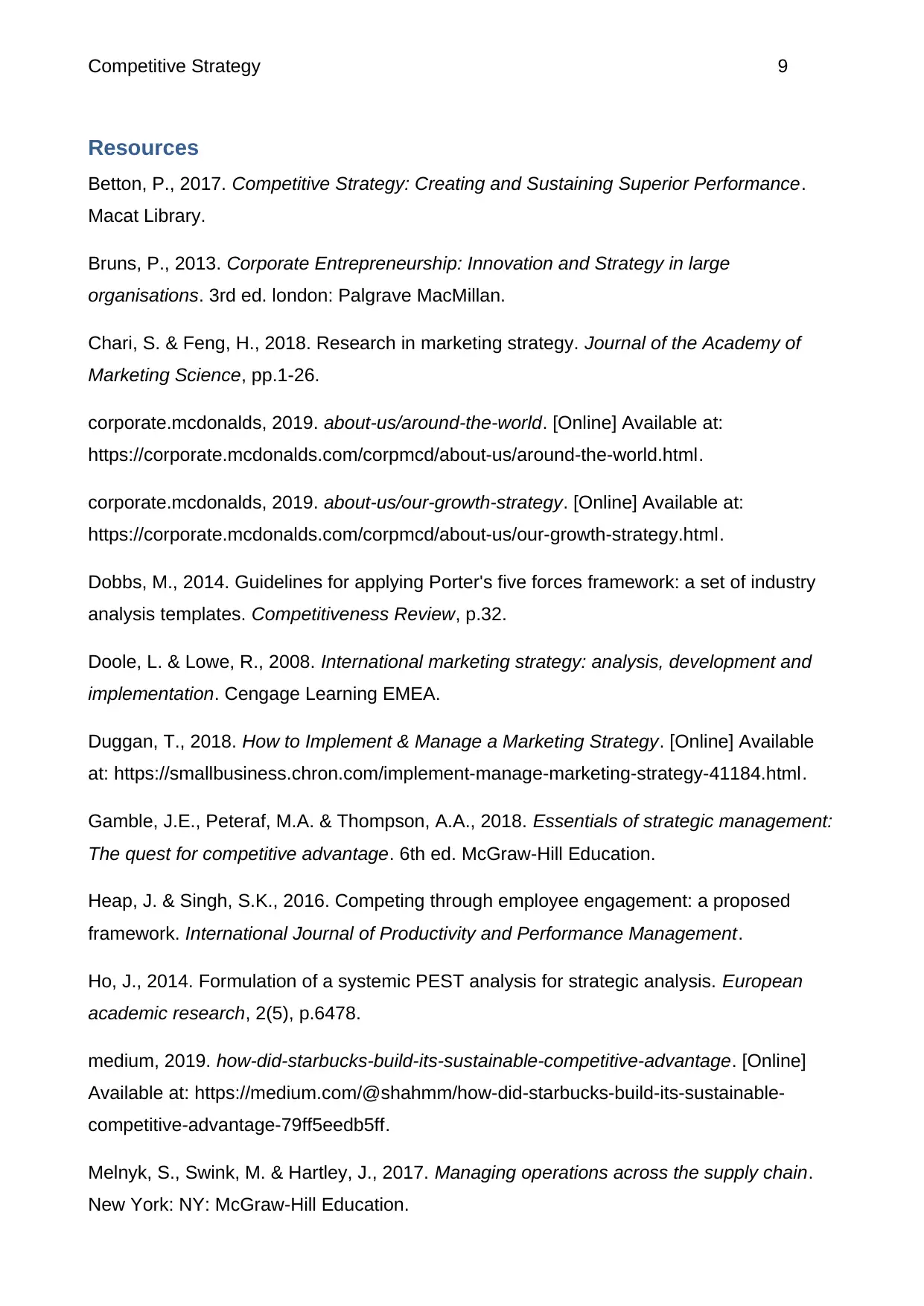
Competitive Strategy 9
Resources
Betton, P., 2017. Competitive Strategy: Creating and Sustaining Superior Performance.
Macat Library.
Bruns, P., 2013. Corporate Entrepreneurship: Innovation and Strategy in large
organisations. 3rd ed. london: Palgrave MacMillan.
Chari, S. & Feng, H., 2018. Research in marketing strategy. Journal of the Academy of
Marketing Science, pp.1-26.
corporate.mcdonalds, 2019. about-us/around-the-world. [Online] Available at:
https://corporate.mcdonalds.com/corpmcd/about-us/around-the-world.html.
corporate.mcdonalds, 2019. about-us/our-growth-strategy. [Online] Available at:
https://corporate.mcdonalds.com/corpmcd/about-us/our-growth-strategy.html.
Dobbs, M., 2014. Guidelines for applying Porter's five forces framework: a set of industry
analysis templates. Competitiveness Review, p.32.
Doole, L. & Lowe, R., 2008. International marketing strategy: analysis, development and
implementation. Cengage Learning EMEA.
Duggan, T., 2018. How to Implement & Manage a Marketing Strategy. [Online] Available
at: https://smallbusiness.chron.com/implement-manage-marketing-strategy-41184.html.
Gamble, J.E., Peteraf, M.A. & Thompson, A.A., 2018. Essentials of strategic management:
The quest for competitive advantage. 6th ed. McGraw-Hill Education.
Heap, J. & Singh, S.K., 2016. Competing through employee engagement: a proposed
framework. International Journal of Productivity and Performance Management.
Ho, J., 2014. Formulation of a systemic PEST analysis for strategic analysis. European
academic research, 2(5), p.6478.
medium, 2019. how-did-starbucks-build-its-sustainable-competitive-advantage. [Online]
Available at: https://medium.com/@shahmm/how-did-starbucks-build-its-sustainable-
competitive-advantage-79ff5eedb5ff.
Melnyk, S., Swink, M. & Hartley, J., 2017. Managing operations across the supply chain.
New York: NY: McGraw-Hill Education.
Resources
Betton, P., 2017. Competitive Strategy: Creating and Sustaining Superior Performance.
Macat Library.
Bruns, P., 2013. Corporate Entrepreneurship: Innovation and Strategy in large
organisations. 3rd ed. london: Palgrave MacMillan.
Chari, S. & Feng, H., 2018. Research in marketing strategy. Journal of the Academy of
Marketing Science, pp.1-26.
corporate.mcdonalds, 2019. about-us/around-the-world. [Online] Available at:
https://corporate.mcdonalds.com/corpmcd/about-us/around-the-world.html.
corporate.mcdonalds, 2019. about-us/our-growth-strategy. [Online] Available at:
https://corporate.mcdonalds.com/corpmcd/about-us/our-growth-strategy.html.
Dobbs, M., 2014. Guidelines for applying Porter's five forces framework: a set of industry
analysis templates. Competitiveness Review, p.32.
Doole, L. & Lowe, R., 2008. International marketing strategy: analysis, development and
implementation. Cengage Learning EMEA.
Duggan, T., 2018. How to Implement & Manage a Marketing Strategy. [Online] Available
at: https://smallbusiness.chron.com/implement-manage-marketing-strategy-41184.html.
Gamble, J.E., Peteraf, M.A. & Thompson, A.A., 2018. Essentials of strategic management:
The quest for competitive advantage. 6th ed. McGraw-Hill Education.
Heap, J. & Singh, S.K., 2016. Competing through employee engagement: a proposed
framework. International Journal of Productivity and Performance Management.
Ho, J., 2014. Formulation of a systemic PEST analysis for strategic analysis. European
academic research, 2(5), p.6478.
medium, 2019. how-did-starbucks-build-its-sustainable-competitive-advantage. [Online]
Available at: https://medium.com/@shahmm/how-did-starbucks-build-its-sustainable-
competitive-advantage-79ff5eedb5ff.
Melnyk, S., Swink, M. & Hartley, J., 2017. Managing operations across the supply chain.
New York: NY: McGraw-Hill Education.
Paraphrase This Document
Need a fresh take? Get an instant paraphrase of this document with our AI Paraphraser
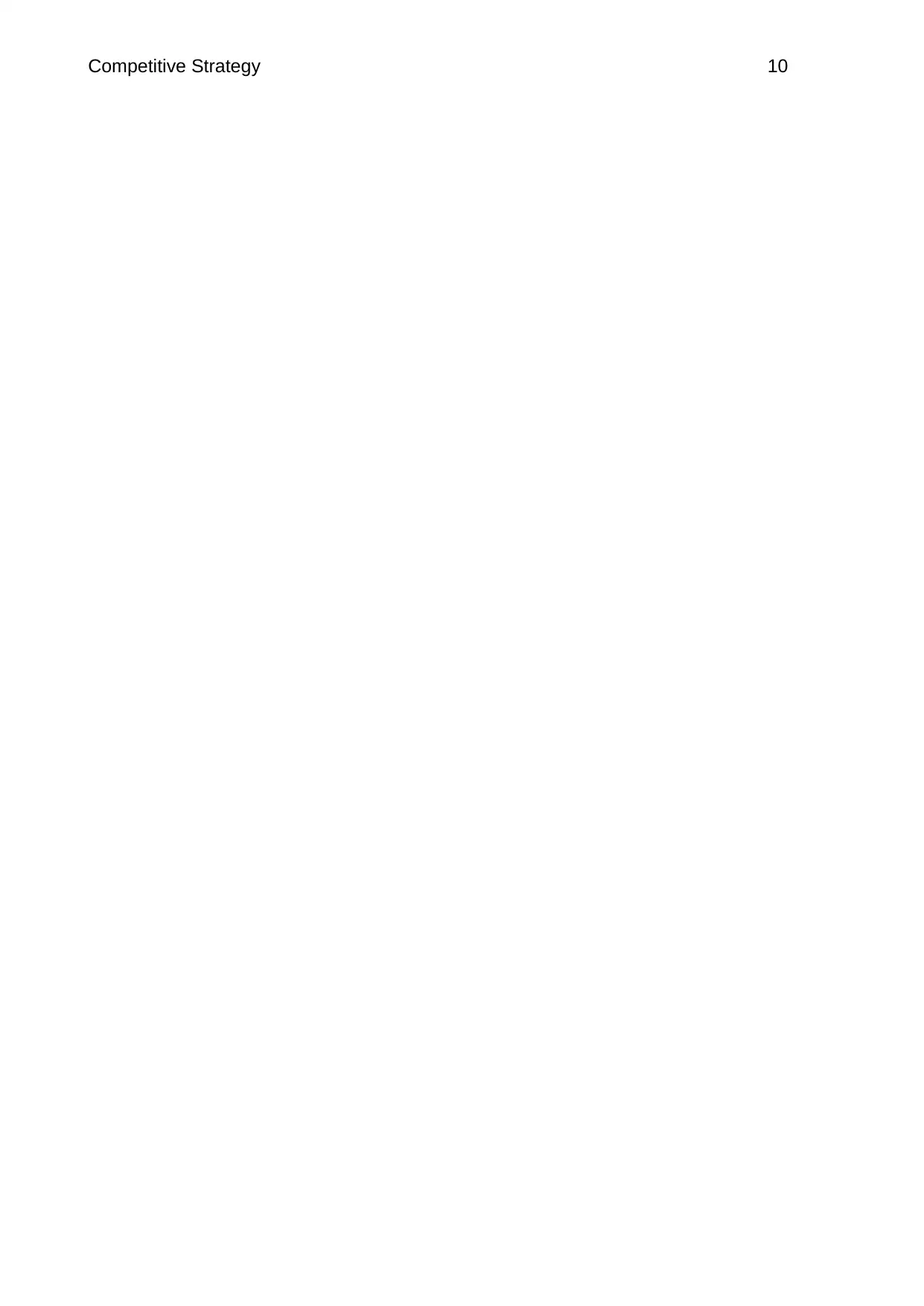
Competitive Strategy 10
1 out of 11
Related Documents
Your All-in-One AI-Powered Toolkit for Academic Success.
+13062052269
info@desklib.com
Available 24*7 on WhatsApp / Email
![[object Object]](/_next/static/media/star-bottom.7253800d.svg)
Unlock your academic potential
Copyright © 2020–2025 A2Z Services. All Rights Reserved. Developed and managed by ZUCOL.




